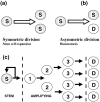Retention of stem cell patterns in malignant cell lines
- PMID: 16300648
- PMCID: PMC6496197
- DOI: 10.1111/j.1365-2184.2005.00355.x
Retention of stem cell patterns in malignant cell lines
Figures


Similar articles
-
Q&A: John Dick on stem cells and cancer.Cancer Discov. 2013 Feb;3(2):131. doi: 10.1158/2159-8290.CD-ND2013-002. Epub 2013 Jan 24. Cancer Discov. 2013. PMID: 23400460 No abstract available.
-
CSCs and pluripotent/multipotent stem cells.Mod Pathol. 2017 Oct;30(10):1336-1337. doi: 10.1038/modpathol.2017.117. Mod Pathol. 2017. PMID: 28972581 No abstract available.
-
Cancer stem cells: at the headwaters of tumor development.Annu Rev Pathol. 2007;2:175-89. doi: 10.1146/annurev.pathol.2.010506.091847. Annu Rev Pathol. 2007. PMID: 18039097 Review.
-
[Cancer stem cells in cancer cell lines].Tanpakushitsu Kakusan Koso. 2005 Dec;50(15):1995-2000. Tanpakushitsu Kakusan Koso. 2005. PMID: 16363650 Japanese. No abstract available.
-
Stem cell-like cancer cells in cancer cell lines.Cancer Biomark. 2007;3(4-5):245-50. doi: 10.3233/cbm-2007-34-508. Cancer Biomark. 2007. PMID: 17917153 Review.
Cited by
-
Histone modifications: Targeting head and neck cancer stem cells.World J Stem Cells. 2014 Nov 26;6(5):511-25. doi: 10.4252/wjsc.v6.i5.511. World J Stem Cells. 2014. PMID: 25426249 Free PMC article. Review.
-
An integrative computational model for intestinal tissue renewal.Cell Prolif. 2009 Oct;42(5):617-36. doi: 10.1111/j.1365-2184.2009.00627.x. Epub 2009 Jul 20. Cell Prolif. 2009. PMID: 19622103 Free PMC article.
-
Mouse sarcoma L1 cell line holoclones have a stemness signature.Cell Prolif. 2010 Jun;43(3):229-34. doi: 10.1111/j.1365-2184.2010.00671.x. Cell Prolif. 2010. PMID: 20546241 Free PMC article.
-
Prostate cancer-derived holoclones: a novel and effective model for evaluating cancer stemness.Sci Rep. 2020 Jul 9;10(1):11329. doi: 10.1038/s41598-020-68187-9. Sci Rep. 2020. PMID: 32647229 Free PMC article.
-
Distinct population of highly malignant cells in a head and neck squamous cell carcinoma cell line established by xenograft model.J Biomed Sci. 2009 Nov 16;16(1):100. doi: 10.1186/1423-0127-16-100. J Biomed Sci. 2009. PMID: 19917110 Free PMC article.
References
-
- Al Hajj M, Clarke MF (2004) Self‐renewal and solid tumor stem cells. Oncogene 23, 7274. - PubMed
Publication types
MeSH terms
LinkOut - more resources
Full Text Sources

